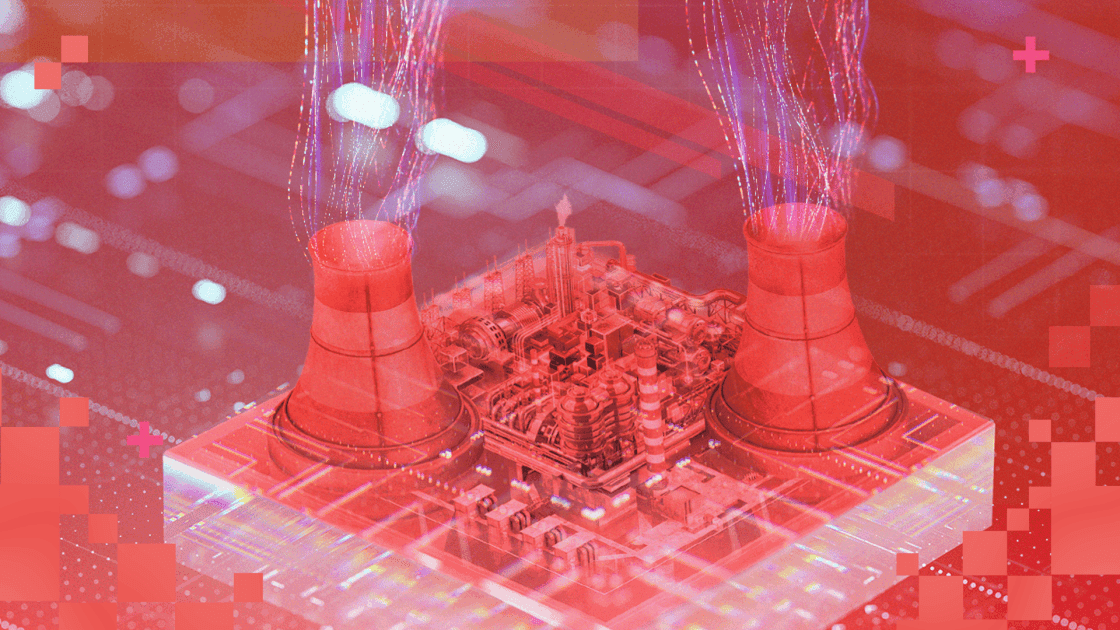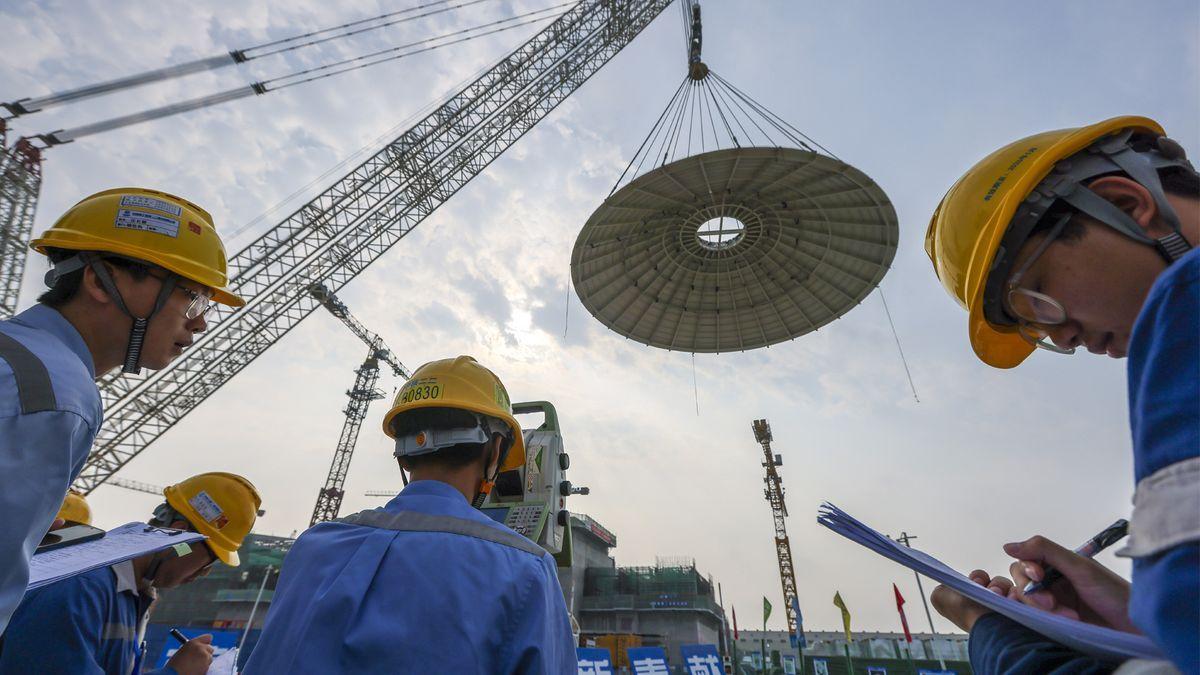AI's Energy Demands Spark Nuclear Renaissance: Miniature Reactors and Uranium Enrichment Revival
2 Sources
2 Sources
[1]
AI could turn your town nuclear
These days, Paducah, Kentucky -- population 27,000 and home to the National Quilt Museum -- prides itself as "Quilt City." But decades ago, it was also called the "Atomic City" -- a moniker it could soon regain as AI's energy needs bring Paducah's nuclear past back to life. The Department of Energy (DOE) operated a uranium enrichment plant in Paducah for more than 60 years until the plant shuttered in 2013 amid a downturn in nuclear energy. The same year, Paducah was designated a UNESCO "creative city" for its quilts, a title it now boasts on its website (along with a city-led initiative to make Paducah more "considerate and kind"). Today, the enrichment facility is in the spotlight again after a Peter Thiel-backed startup announced plans to revive the shuttered plant. In July, Donald Trump's administration also chose Paducah as one of four sites where it says it'll partner with private companies to develop AI data centers and energy projects. Big Tech -- thirsty for enough electricity to power its AI ambitions -- wants to make nuclear energy cool again. It's all playing into the Trump administration's plans to remake the US power grid without solar and wind power. If they manage to revitalize nuclear energy in America, the US is going to need more enriched uranium. And that supply chain could bring big changes to even small cities like Paducah. General Matter emerged from stealth mode earlier this year, led by former SpaceX engineer Scott Nolan. Peter Thiel, who cofounded PayPal and the datamining company Palantir that's selling software to the Trump administration to surveil people who migrate to the US, joined General Matter's board. And Nolan stood in the Oval Office with Trump on May 23rd as he signed executive orders ostensibly aimed at ushering in "a nuclear energy renaissance." At an August 5th event in Paducah, General Matter shared details about its vision for the facility. It says it'll develop what it considers the "the nation's first U.S.-owned, privately developed uranium enrichment facility" on the site and that it has signed "a multi-decade, one hundred-acre lease" with the DOE. General Matter plans to start enriching uranium in Paducah by the end of the decade and "produce the fuel needed for the next generation of nuclear energy, central to America's aspirations in AI, manufacturing, and other critical industries," according to a statement on X. (A DOE press release says enrichment operations aren't planned until 2034, however, and that construction is slated to start in 2026.) That doesn't quite answer some key questions about the company's plans. (General Matter didn't respond to several emails from The Verge.) Will the company rely on the same outdated technology the shuttered plant has always used or build something new? If it does plan to revamp the facility with modern technology, does it plan to produce the same kind of low-enriched uranium that America's existing nuclear reactors run on, or does it think it can be one of the first plants to produce more highly enriched uranium (called HALEU) for advanced reactors? The answers to those questions will define how ambitious of a project this really is, and the impact it could have on power grids across the US. The recent DOE press release notes that General Matter is one of four companies the agency selected in October of last year to provide enrichment services for HALEU, although the DOE also announced plans to contract General Matter for low-enriched uranium in December. Enrichment is just one step, and kind of a headache, in the nuclear supply chain. Uranium first has to be mined and milled. Naturally occurring uranium has low levels of the isotope U-235 that nuclear fission reactors split to release energy. The uranium has to be converted into gas and then enriched to about a 5 percent concentration of U-235 to make fuel for a traditional reactor. Following a boom in nuclear power plants built in the 1970s and 1980s, however, the industry lost ground to gas-fired power plants generating electricity at lower costs. Nuclear reactors and uranium enrichment plants shuttered across the US. But now, the opposite is happening. Microsoft and Meta have inked deals over the past year to revive old reactors. Other tech giants, including Amazon and Google, have committed to supporting companies designing advanced reactors that are supposed to be smaller, easier, and cheaper to build -- potentially solving many of the problems that have plagued the nuclear energy industry for years, if they can eventually prove that these technologies are going to be able to perform at commercial scale. That's all driving up demand for uranium enrichment, now seen as a significant bottleneck in the nuclear energy supply chain. General Matter isn't the only operation seeking to enrich uranium in Paducah. The DOE has had a deal with another company called Global Laser Enrichment (GLE) since 2016 to sell it leftover tails, depleted uranium, from years of enrichment for nuclear weapons and reactors at the site. GLE has been developing a new way to enrich uranium using lasers that's supposed to be efficient enough to re-enrich uranium tails so that they can be used to make fuel again. General Matter similarly plans to re-enrich depleted uranium tails in Paducah, according to the DOE press release, although we still don't know what kind of technology it will use to do so. Laser technology has yet to be used to enrich uranium at commercial scale. Over the past decade, there just wasn't enough demand for more uranium enrichment capacity in the US to move forward, says Nima Ashkeboussi, vice president of government relations and communications at GLE. Then Russia -- a major supplier for nuclear fuel globally -- invaded Ukraine, and in 2024, and the US barred imports of uranium from Russia. GLE applied for a license in June to finally start re-enriching the depleted uranium tails at a site adjacent to the Paducah plant, and expects to hear back from the Nuclear Regulatory Commission in about 18 months. If all goes well, GLE plans to have its facility up and running by 2030 so it can start making the low-enriched uranium traditionally used by existing nuclear reactors. If at least one of the advanced reactors makes it to commercial operation, Ashkeboussi says that'll be a market signal that it can start producing more highly enriched uranium (called HALEU) that next-generation reactors need. For now, only Russia has the capability to commercially produce HALEU. But already, data centers and AI have been a major driver in reinvigorating nuclear energy, Ashkeboussi tells The Verge. "We see that as a huge growth potential," he says. Both the Biden and Trump administrations have worked toward onshoring the nuclear supply chain again. The US currently has the capacity to enrich about a third of the uranium its nuclear reactors need. For Joe Biden, nuclear energy supported US climate goals of slashing planet-heating pollution by transitioning away from fossil fuels in the power grid. Trump is sabotaging US climate commitments and renewable energy projects, but still says nuclear energy has a role to play when it comes to making sure US tech companies have enough electricity to dominate the AI market. The plans for Paducah seem to fit neatly into the Trump administration's vision for AI, which it released last month. In short, the plan includes fast-tracking the development of energy-hungry data centers in conjunction with primarily fossil fuel and nuclear power plants by limiting environmental reviews. The rush to build, especially as the Trump administration simultaneously guts the Environmental Protection Agency and Nuclear Regulatory Commission, has raised some flags over how much oversight and community participation there will be with these new projects. "I don't have any confidence in what the administration is doing to protect public health and safety. It seems their mindset is construction and production at all costs," says Edwin Lyman, director of nuclear power safety at the Union of Concerned Scientists that has been critical of the environmental and security risks nuclear energy can pose. Nuclear energy has been a divisive technology among people concerned about climate change and pollution. It's a carbon pollution-free source of electricity. But uranium mining near the Grand Canyon has already sparked opposition from environmental advocates and the Havasupai Tribe over how it could affect nearby communities and the water sources on which they rely. And the federal government has yet to solve decades of wrangling over where to store radioactive waste from nuclear reactors. Adding to those concerns, the Trump administration wants to build on federal lands and even repurpose polluted Superfund sites for all this infrastructure. The shuttered enrichment plant in Paducah itself is a Superfund site, which means it's on a list of places so contaminated that the Environmental Protection Agency has stepped in to prioritize their cleanup. That legacy shows the pitfalls and hurdles that policymakers and companies will have to try to avoid if they want to bring nuclear energy back to small-town USA. "Regardless of what's happening with the Trump administration, this is a massively bipartisan undertaking regarding uranium enrichment. There is a lot of support for it right now. I think there's a lot of momentum to really get it right," says Rowen Price, senior policy advisor for nuclear energy at the nonprofit Third Way, which supports nuclear energy. Local lawmakers, for their part, have shown optimism over Paducah potentially playing a pivotal role in the future of AI and energy in the US. General Matter's $1.5 billion proposed project in Paducah is supposed to create 140 jobs, according to Kentucky Governor Andy Beshear (D-KY). "Just a few years ago, the idea of Kentucky leading the next wave of nuclear energy development may have seemed ambitious," Sen. Danny Carroll (R-KY) wrote in an op-ed in the Lexington Herald-Leader. "Paducah is again at the center of America's nuclear future."
[2]
These nuclear reactors fit on a flatbed truck. How safe are they?
The nuclear industry aims to miniaturize, looking to place hundreds of small power plants across the nation. The Golden Chest Mine in the far northern reaches of Idaho seems an unlikely staging ground for clean power innovation. It is a throwback to an earlier era, the last hard rock gold mine in Idaho, where heavy machinery bores deep into the earth. But mine owner Idaho Strategic Resources plans to make the operation a showcase for a new energy source: miniaturized nuclear power. The company wants to power its mining machines with a nuclear reactor small enough to be packed in a shipping container and loaded on a truck. The project would put the company in the vanguard of micro-reactor development, which backers say could spur wider use of nuclear energy. At least a half dozen companies are racing to develop tiny reactors, which bear no resemblance to the hulking power projects dotting riverbanks and coastlines across the United States, with their cooling towers and massive concrete containment structures. The flatbed-size reactors are designed to generate as little as a single megawatt of power -- roughly one-thousandth the amount of a large legacy unit. It's enough to power 1,000 homes, a single manufacturing plant or even a remote island owned by a billionaire (one company claims it has received such an inquiry). They generally don't require water for coolant, instead using helium gas, molten salt or air-cooled alkali metal pipes to carry heat away from the core. For fuel, they rely on a novel type of uranium pellet that the Energy Department has declared "meltdown-proof." It's an attractive prospect for remote energy customers seeking cheaper and cleaner alternatives to diesel generators and coal boilers. Some scientists say industry and government claims of safety are vastly overblown. They contend a radiological release still could be triggered by an explosion or technical malfunction that ruptures a small reactor. They also point out that the United States, after decades of futility and frustration, has yet to find a solution for permanently disposing of highly radioactive nuclear waste. "The idea that we will start trucking these all over country, putting them in nooks and crannies in populated areas next to data centers and factories without any off-site emergency planning, is just madness," said Ed Lyman, director of nuclear power safety at the Union of Concerned Scientists. "It is not justified by the science." But the Energy Department under both Republican and Democratic administrations has promoted the technology as a viable on-demand clean energy alternative. Now the government is pushing ahead with tests -- at a fortified lab in Idaho -- of multiple, competing micro-reactor designs. If one or more emerge as successful, it could be the first new commercial nuclear reactor design used in the U.S. since the early years of the Cold War. Developers of the technology hope to get the first of them running as soon as 2028 and envision installing them widely by the early 2030s. "We do a lot of looking at what the mine of the future might be," said Travis Swallow, Idaho Strategic director of business development. "We believe nuclear plays a key role." The mini nukes, associated turbines and switching machinery would arrive at a site like a life-size Erector Set. The entire plant footprint takes up as little as two acres. "People hear 'nuclear' and they think Chernobyl," said Jon Conrad, director of governmental affairs at Tata Chemicals, which hopes to replace dirty coal boilers with microreactors at a Wyoming factory that processes soda ash, a white powder used in toothpaste, laundry detergent and glass. "They ask us how large this will be, and if we will have these huge cooling towers," Conrad said. "It is nothing like that." The concept of a small, safe reactor that doesn't have the financial and public health risks, engineering challenges, and environmental baggage of legacy models has intrigued the nuclear industry for decades. The Nuclear Regulatory Commission is looking to streamline approval of the microreactors, saying that their "reduced risk profiles and enhanced safety features" may warrant expedited action. But community concerns will factor into its decisions. Without a federal disposal plan, nuclear waste could linger at project sites for decades. Another challenge is finding the highly enriched uranium needed to power the new reactors. It is not currently manufactured in the U.S., and companies are reluctant to invest in facilities to make it until they are certain microreactors are viable and a substantial number of them will be deployed. "We are going to soon find out what communities are willing to accept," said Ted Nordhaus, co-founder of the Breakthrough Institute, which advocates for nuclear power and other technological solutions to environmental problems. Idaho Strategic would purchase its reactors from a California start-up called Radiant. They would first be used at Golden Chest, which is connected to the power grid, so there is a backstop in the event of early glitches. But its hope is microreactors ultimately could replace diesel generators or the need to build power lines to remote, off-the-grid sites at costs of up to $1 million per mile. A mobile nuclear reactor that needs to be fueled only every five years is an attractive alternative, said Tori Shivanandan, chief operating officer of Radiant. Radiant plans to haul away the waste when it refuels client reactors and store it at a manufacturing site the company is seeking to build north of Casper, Wyoming. The proposal to indefinitely store the waste of all Radiant clients in Wyoming is not warmly welcomed by locals. "I've talked to all my neighbors," Mitchell Groskopf, a Bar Nunn resident who lives near the proposed site, said at a recent public meeting. "Every single one of them is against it. I feel like it is moving way too fast." Rep. Bill Allemand, a Republican who represents the area in the state House, warned county commissioners against approving Radiant's plan to ultimately manufacture as many as 50 of the reactors each year in Bar Nunn, storing all the spent fuel cores on-site. "When we look 30 years down the road, they have hundreds of these things coming in," Allemand said. "The people of Bar Nunn do not want this." Radiant is undeterred. "We're confident in the broad support from a majority of local elected officials and the community who want the hundreds of good-paying jobs we plan to bring to the area," said Ray Wert, a company vice president, in an email. In a U.S. nuclear industry that has a reputation for overpromising and underdelivering -- the last commercial reactors to come online were nearly $20 billion over budget and seven years behind schedule -- the commercial microreactor had been dismissed as too expensive, impractical and dangerous to distribute widely. But soaring demand, driven in large part by the explosive needs of AI developers, is causing large-scale energy users to reconsider. By next year, as many as three different microreactors will be installed in a domed, concrete-reinforced testing building at Idaho National Laboratory, a final stop for working out any kinks before the technology can be licensed and sold commercially. At least five companies vying to be the first to market are already inking deals with potential clients. They include Radiant, legacy nuclear manufacturer Westinghouse and military contractor BWXT in Virginia, which has partnered with Tata. "Our customers are demanding a cleaner and more environmental product," said Conrad of Tata Chemicals. "Coal is an oxymoron in that equation." The boom in commercial interest in microreactors is driven in large part by developments in what is known as TRISO fuel, short for TRi-structural ISOtropic. According to the Energy Department, it seals uranium in poppyseed-size pellets coated with layers of heatproof material that keeps radiation from escaping to the outside in even the most extreme conditions, such as a fire or an earthquake. "It keeps the bad stuff on the inside from getting out," said Erik Nygaard, director of product development at BWXT's new Lynchburg, Virginia, innovation campus. "You are creating the kind of containment that used to require big concrete structures and basically collapsing it into the head of a pin." Some scientists are less confident in the fuel, which they say has not been proved to withstand the extreme heat that can occur during a reactor malfunction. At BWXT's sprawling new campus in Lynchburg, there is an entire airplane-hangar-size section for Project Pele, the name of a Defense Department effort to build a tiny reactor for military bases. The unit is being assembled in preparation for delivery to the federal testing facility in Idaho. Engineers are putting components through an array of stress tests, examining them under industrial-scale CT scan machines to check for defects and subjecting them to scorching hydrogen-powered furnaces. The company has long made the small reactors that power Navy vessels. But those run on highly enriched, weapons-grade fuel and are not safe for commercial use. Down the hall from the Project Pele staging area at the BWXT campus is another cavernous section where the company is developing a microreactor that could be used for space exploration and satellite launches. Kate Kelly, president of BWXT Advanced Technologies, explains that it could also be used to "provide power on the surface of the moon to support human exploration or a commercial lunar economy." "Activity in space is increasing pretty significantly," she said. "To support that, you need increased power." There are still numerous challenges to overcome before tiny nuclear reactors are deployed in space. A federal demonstration program called Project DRACO was canceled earlier this year amid concerns the technology cannot be manufactured cheaply enough to make it cost competitive. At another mini-nuclear company called Nano Nuclear, CEO James Walker said potential clients include manufacturers and government officials in the Philippines and Indonesia looking for reliable power for remote islands. Walker said a billionaire approached Nano inquiring whether the microreactor could be used to power a self-sustaining island community. "They asked if it was possible to have a project where this could power their own vertical farm and their own desalination plant on an island that is completely self-sufficient," Walker said. "We communicated back that it is certainly possible."
Share
Share
Copy Link
The growing energy needs of AI are driving a resurgence in nuclear power, with tech giants backing new nuclear projects and startups developing miniature reactors. This shift is reviving uranium enrichment facilities and sparking debates about safety and waste management.
AI's Insatiable Energy Appetite Fuels Nuclear Revival
The burgeoning artificial intelligence (AI) industry's voracious appetite for electricity is breathing new life into the nuclear energy sector. Tech giants, grappling with the power demands of their AI ambitions, are turning to nuclear energy as a viable solution, sparking a renaissance in an industry that had been in decline
1
.Paducah: From Quilt City to Atomic City Redux

Source: The Verge
Paducah, Kentucky, once known as "Atomic City," is at the forefront of this nuclear resurgence. The city's shuttered uranium enrichment plant, closed in 2013, is now set for revival. General Matter, a Peter Thiel-backed startup, has announced plans to develop "the nation's first U.S. privately developed uranium enrichment facility" on the site
1
. This move aligns with the Trump administration's selection of Paducah as one of four sites for AI data centers and energy projects.Miniaturization: The Future of Nuclear Power?
While Paducah focuses on uranium enrichment, another trend is emerging in the nuclear industry: miniaturization. Companies are racing to develop micro-reactors, some small enough to fit on a flatbed truck. These miniature nuclear plants, generating as little as one megawatt of power, could potentially power remote locations, manufacturing plants, or even private islands
2
.Tech Giants and Nuclear Partnerships
Major tech companies are actively supporting the nuclear revival:
- Microsoft and Meta have made deals to revive old reactors
- Amazon and Google are backing companies designing advanced reactors
- These partnerships aim to secure the massive amounts of electricity needed for AI operations
1
Safety Concerns and Regulatory Challenges
The development of micro-reactors has raised safety concerns among some scientists. Critics argue that the industry's claims of safety are exaggerated and that the risk of radiological release remains
2
. The Nuclear Regulatory Commission is considering streamlining the approval process for these reactors, citing their "reduced risk profiles and enhanced safety features"2
.Related Stories
Uranium Enrichment: A Critical Bottleneck
The revival of nuclear energy has highlighted uranium enrichment as a significant bottleneck in the supply chain. Companies like General Matter and Global Laser Enrichment are working to address this issue, with plans to re-enrich depleted uranium tails in Paducah
1
.Novel Technologies and Fuel Sources
These new reactors employ innovative cooling methods, using helium gas, molten salt, or air-cooled alkali metal pipes instead of water. They also utilize a new type of uranium pellet that the Energy Department has labeled "meltdown-proof"
2
.Waste Management and Community Concerns
The lack of a federal disposal plan for nuclear waste remains a significant challenge. Some companies, like Radiant, propose storing waste at their manufacturing sites, a solution that has met with resistance from local communities
2
.As the nuclear industry adapts to meet the energy demands of the AI era, it faces the dual challenges of ensuring safety and gaining public acceptance. The success of these initiatives could reshape the energy landscape and have far-reaching implications for the future of AI and technology infrastructure.
References
Summarized by
Navi
[1]
[2]
Related Stories
Recent Highlights
1
Nvidia drops $20 billion on AI chip startup Groq in largest acquisition ever
Business and Economy

2
Meta acquires Manus for $2 billion, adding revenue-generating AI agents to its platforms
Business and Economy

3
China proposes world's strictest AI chatbot rules to prevent suicide and emotional manipulation
Policy and Regulation







